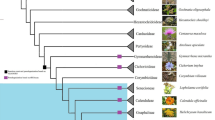Summary
The light-regulated nuclear gene encoding subunit A of chloroplast glyceraldehyde-3-phosphate dehydrogenase (subunit GAPA, geneGpa1) from maize is extremely G+C rich (67% in codons). The genomic surroundings of this gene have been characterized together with the sequences of two strongly conservedGpa pseudogenes isolated from a genomic maize library by differential cDNA hybridization. The comparisons show that the high G+C content of the maize gene is maintained independently of the surrounding noncoding sequences, which are G+C poor (42%), and only as long as the gene encodes a functional protein. After nonfunctionalization,Gpa pseudogenes rapidly loose G+C mainly due to enhanced turnover of CpG and CpXpG methylation sites. These results suggest that the maizeGpa1 gene is under strong functional GC pressure, due to constraints (CpG island) probably exerted at the transcriptional level. They also indicate thatGpa pseudogenes are methylated and that methylation was either the cause or the immediate consequence of their nonfunctionalization. It can be concluded further that the progenitor of pseudogenes 1 and 2 was a second functionalGpa gene (Gpa′), which, after duplication, accelerated in evolutionary rate due to relaxation of selective constraints. This is in agreement with the neutral theory of evolution. Comparison ofGpa intron sequences reveals a gradient of divergence: the more 3′ the position of an intron the more its sequence has diverged between the threeGpa genes. A speculative model is presented explaining these observations in terms of a homologous recombination of genes with their reverse-transcribed pre-mRNAs.
Similar content being viewed by others
References
Antequera F, Bird AP (1988) Unmethylated CpG islands associated with genes in higher plant DNA. EMBO J 7:2295–2299
Aota S, Ikemura T (1986) Diversity in G+C content at the third position of codons in vertebrate genes and its cause. Nucleic Acids Res 14:6345–6355
Bernardi G, Bernardi G (1986) Compositional constraints and genome evolution. J Mol Evol 24:1–11
Bernardi G, Olofsson B, Filipski J, Zerial M, Salinas J, Cuny G, Meunier-Rotival M, rodier F (1985) The mosaic genome of warm-blooded vertebrates. Science 228:953–958
Biesecker G, Harris JI, Thierry JC, Walker JE, Wonacott AJ (1977) Sequence and structure of D-glyceraldehyde 3-phosphate dehydrogenase fromBacillus stearothermophilus. Nature (Lond) 266:328–333
Bird AP (1987) CpG islands as gene markers in the vertebrate nucleus. Trends Genet 3:342–347
Bird AP, Taggart MH, Nicholls RD, Higgs DR (1987) Nonmethylated CpG-rich islands at the human α-globin locus: implications for evolution of the α-globin pseudogene. EMBO J 6:999–1004
Brinkmann H, Martinez P, Quigley F, Martin W, Cerff R (1987) Endosymbiotic origin and codon bias of the nuclear gene for chloroplast glyceraldehyde 3-phosphate dehydrogenase from maize. J Mol Evol 26:320–328
Brinkmann H, Cerff R, Salomon M, Soll J (1989) Cloning and sequence analysis of cDNAs encoding the cytosolic precursors of subunits GapA and GapB of chloroplast glyceraldehyde-3-phosphate dehydrogenases from pea and spinich. Plant Mol Biol 13:81–94
Cedar H (1988) DNA methylation and gene activity. Cell 53: 3–4
Cerff R, Kloppstech K (1982) Structural diversity and differential light control of mRNAs coding for angiosperm glyceraldehyde-3-phosphate dehydrogenases. Proc Natl Acad Sci USA 79:7624–7628
Chojecki J (1986) Identification and characterization of a cDNA clone for cytosolic glyceraldehyde-3-phosphate dehydrogenase in barley. Carlsberg Res Commun 51:203–210
Drouin G, Dover GA (1987) A plant processed pseudogene. Nature 328:557–558
Federoff N (1983) Plant Mol Biol Rep 1:27–29
Frischauf A-M, Lehrbach H, Poustka A, Murray N (1983) J Mol Biol 170:827–842
Grandbastien M-A, Spielmann A, Caboche M (1989) Tntl, a mobile retroviral-like transposable element of tobacco isolated by plant cell genetics. Nature 337:376–380
Gruenbaum Y, Naveh-Many T, Cedar H, Razin A (1981) Sequence specificity of methylation in higher plant DNA. Nature 292:860–862
Hanauer A, Mandel JL (1984) The glyceraldehyde 3-phosphate dehydrogenase gene family: structure of a human cDNA and of an X chromosome linked pseudogene; amazing complexity of the gene family in mouse. EMBO J 3:2627–2633
Hohn B (1979) In: Colowick SP, Kaplan NO (eds) Methods in enzymology 68:299–309
Jukes TH, Cantor CR (1969) Evolution of protein molecules. In: Munro HN (ed) Mammalian protein metabolism. Academic Press, New York, pp 21–123
Klösgen RB, Gierl A, Schwarz-Sommer ZS, Saedler H (1986) Molecular analysis of thewaxy locus ofZea mays. Mol Gen Genet 203:237–244
Li WH, Gojobori T (1983) Rapid evolution of goat and sheep globin genes following gene duplication. Mol Biol Evol 1:94–108
Li WH, Luo CC, Wu CI (1985) Evolution of DNA sequences. In: MacIntyre RJ (ed) Molecular evolutionary genetics. Plenum New York, pp 1–94
Limbach KJ, Wu R (1985) Characterization of twoDrosophila melanogaster cytochrome c genes and their transcripts. Nucleic Acids Res 13:631–644
Maniatis T, Fritsch EF, Sambrook G (1982) Synthesis of cDNA. In: Molecular cloning. A laboratory manual. Cold Spring Harbor Laboratory Press, New York, pp 211–246
Martin W, Cerff R (1986) Prokaryotic features of a nucleusencoded enzyme. Eur J Biochem 159:323–331
Martinez P, Martin WF, Cerff R (1989) Structure, evolution and anaerobic regulation of a nuclear gene encoding cytosolic glyceraldehyde-3-phosphate dehydrogenase (GAPC) from maize. J Mol Biol 208:551–566
Niesbach-Klösgen U, Barzen E Bernhardt J, Rohde W, Schwarz-Sommer ZS, Reif HJ, Wienand U, Saedler H (1987) Chalcone synthase genes in plants: a tool to study evolutionary relationships. J Mol Evol 26:213–225
Piechaczyk M, Blanchard JM, Sabouty SR-E, Dani C, Marty L, Jeanteur P (1984) Unusual abundance of vertebrate 3-phosphate dehydrogenase pseudogenes. Nature 312:469–471
Quigley F, Martin WF, Cerff R (1988) Intron conservation across the prokaryote-eukaryote boundary: structure of the nuclear gene for chloroplast glyceraldehyde-3-phosphate dehydrogenase from maize. Proc. Natl Acad Sci USA 85:2672–2676
Russel D, Sachs M (1989) Differential expression and sequence analysis of the maize glyceraldehyde-3-phosphate dehydrogenase gene family. The Plant Cell 1:793–803
Saedler H, Nevers P (1985) Transposition in plants: a molecular model. EMBO J 4:585–590
Salinas J, Matassi G, Montero LM, Bernardi G (1988) Compositional compartmentalization and compositional patterns in the nuclear genomes of plants. Nucleic Acids Res 16:4269–4285
Schwarz-Sommer ZS, Gierl A, Klösgen RB, Wienand U, Peterson PA, Saedler H (1984) The Spm (En) transposable element controls the excision of a 2 kb DNA insert at thewx-m8 allele ofZea mays. EMBO J 3:1021–1028
Stone EM, Rothblum KN, Alevy MC, Kuo TM, Schwartz RJ (1985) Complete sequence of the chicken glyceraldehyde-3-phosphate dehydrogenase gene. Proc Natl Acad Sci USA 82: 1628–1632
Sueoka N (1988) Directional mutation pressure and neutral molecular evolution. Proc Natl Acad Sci USA 85:2653–2657
Voytas DF, Ausubel FM (1988) A copia-like transposable element family inArabidopsis thaliana. Nature 336:242–244
Wolfe KH, Li W-H, Sharp PM (1987) Rates of nucleotide substitution vary greatly among plant mitochondrial, chloroplast and nuclear DNAs. Proc Natl Acad Sci USA 84:9054–9058
Wu CI, Li WH, Shen JJ, Scarpulla RC, Limbach KJ, Wu R (1986) Evolution of cytochrome c genes and pseudogenes. J Mol Evol 23:61–75
Author information
Authors and Affiliations
Rights and permissions
About this article
Cite this article
Quigley, F., Brinkmann, H., Martin, W.F. et al. Strong functional GC pressure in a light-regulated maize gene encoding subunit GAPA of chloroplast glyceraldehyde-3-phosphate dehydrogenase: Implications for the evolution of GAPA pseudogenes. J Mol Evol 29, 412–421 (1989). https://doi.org/10.1007/BF02602911
Received:
Revised:
Issue Date:
DOI: https://doi.org/10.1007/BF02602911




